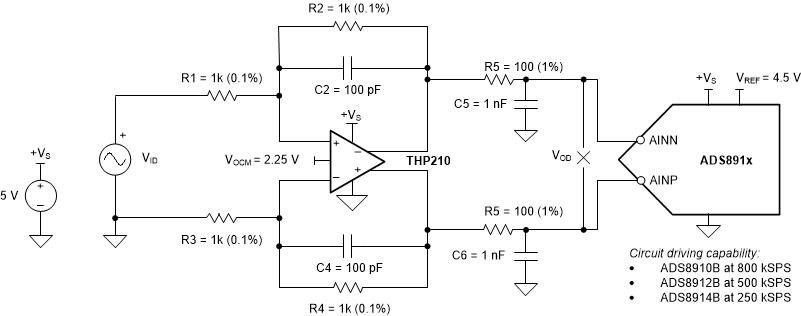SBOS932C January 2020 – March 2021 THP210
PRODUCTION DATA
- 1 Features
- 2 Applications
- 3 Description
- 4 Revision History
- 5 Pin Configuration and Functions
- 6 Specifications
- 7 Parameter Measurement Information
- 8 Detailed Description
-
9 Application and Implementation
- 9.1 Application Information
- 9.2 Typical Applications
- 10Power Supply Recommendations
- 11Layout
- 12Device and Documentation Support
- 13Mechanical, Packaging, and Orderable Information
Package Options
Mechanical Data (Package|Pins)
Thermal pad, mechanical data (Package|Pins)
Orderable Information
9.2.2 ADS891x With Single-Ended RC Filter Stage
The application circuit in Figure 9-12 shows the schematic of a complete reference driver circuit that generates a full-scale range of 4.5 V at the ADC using a unipolar supply voltage of 5 V. This circuit is used to measure the driving capability of the THP210 with the different variants of the ADS891x ADC.
To test the complete dynamic range of the circuit, the common-mode voltage VOCM of the input of the ADC is established at a value of VREF / 2. To exclude distortion caused by reference voltage VREF and common-mode voltage VOCM of the ADC, the test circuit uses the low-noise OPA2625 in an inverting gain configuration for VOCM, and the high-precision, low-noise REF5050 for VREF. See the ADS8910BEVM-PDK user's guide for more details.
 Figure 9-12 Driving ADS891x With
Single-Ended RC Filter Stage
Figure 9-12 Driving ADS891x With
Single-Ended RC Filter Stage